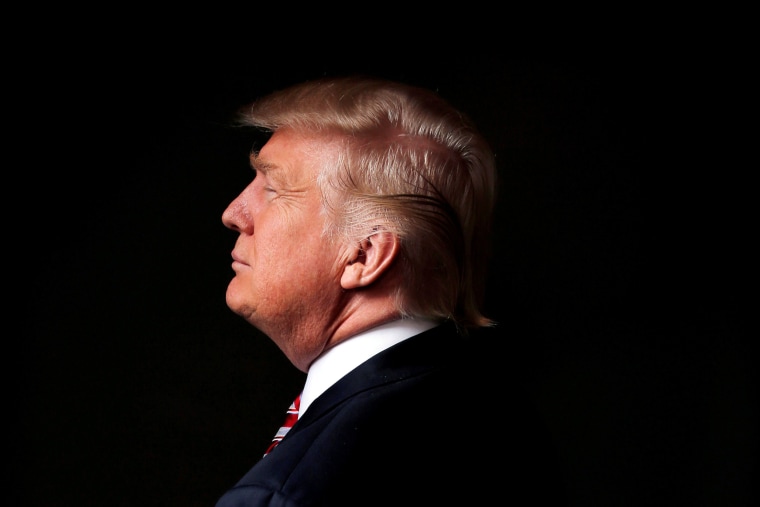As President-elect Donald Trump prepares to be sworn in as the country’s commander-in-chief next month, a majority of Americans say they are either uncertain or pessimistic about his presidency, even as the country is sounding a more optimistic tone about the future of the economy and Trump’s ability to bring positive change to Washington D.C.
A new NBC News/Wall Street Journal poll finds 54 percent of adults saying that they are either uncertain (25 percent) or pessimistic and worried (29 percent) about how Trump will perform during his presidency, compared with 45 percent with either an optimistic and confident view (22 percent) or a satisfied and hopeful view (23 percent).
That’s a significantly worse outlook than Americans expressed after the elections of both Barack Obama and George W. Bush. A combined 66 percent were either optimistic or hopeful about Obama in January 2009, according to the same poll, while 59 percent were optimistic or hopeful about George W. Bush in January 2001.
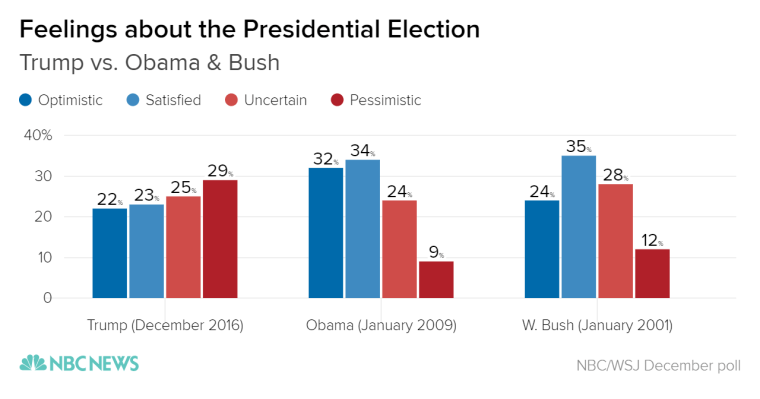
The data show the extent to which the nation remains unusually divided even though Election Day is in the rearview mirror, said Democratic pollster Fred Yang of Hart Research Associates, which conducted this survey with Republican pollster Bill McInturff and his firm Public Opinion Strategies.
“Usually elections settle arguments and the nation comes together, at least in the short term,” Yang said. “Today, hard feelings persist on both sides of the partisan divide. It’s as if the 2016 campaign has never ended.”
Those partisan differences are particularly stark when it comes to public approval ratings of the way Trump is handling his transition. Half of the country overall gives Trump high marks so far, compared to 41 percent who give him a thumbs down. But among Hillary Clinton's voters, only 12 percent approve of how he’s handling the transition, compared to 92 percent of Trump voters.
Back in 2008, 50 percent of John McCain's voters approved of Barack Obama’s handling of his presidential transition, and in 1992, 63 percent of George H.W. Bush's voters backed Bill Clinton’s early moves as president-elect.
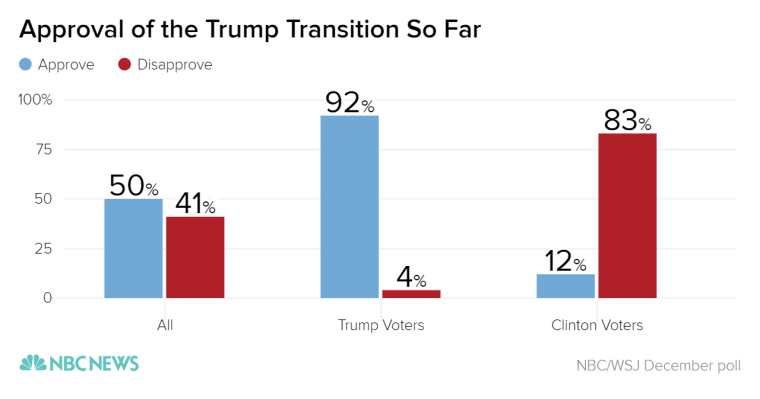
The partisan divide extends to views about the men and women Trump has selected to lead his administration. Seventy-eight percent of Democrats say they are disappointed with the administration appointments Trump has made so far, while 80 percent of Republicans say they are generally pleased with Trump’s picks.
While Trump’s overall favorability has ticked up modestly since before the election, he remains underwater, with more Americans giving him a poor rating (46 percent) than a positive one (40 percent.)
That marks the first time that an incoming president has been viewed more negatively than positively in the history of the NBC/WSJ poll.
Some bright spots -- but ones mostly driven by enthusiasm from Trump's supporters
While the public is largely apprehensive about the president-elect, Americans do say that they are more optimistic that the U.S. economy will improve in the next year. Forty-two percent say they believe the economy will get better – the highest share since autumn of 2012 -- while only 19 percent say the economy will get worse in the next year.
Trump has also generated relatively positive feelings about his ability to change the federal government for the better. A majority of Americans say Trump will shake up the way government operates – and, among that group, they believe that he’ll bring the right kind of change by a two-to-one margin (41 percent to 20 percent).
Additionally, a majority - fifty-six percent - say they are optimistic that Trump will keep U.S. jobs from going overseas.
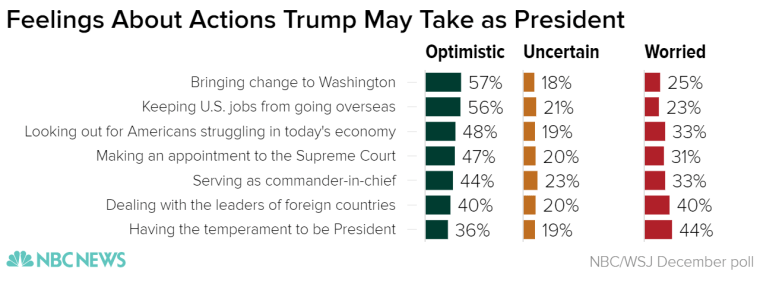
Still, the confidence about Trump’s presidency is mostly fueled by enthusiasm among his base voters rather than by more hopeful expectations among those who didn’t choose him on their ballot in November.
A whopping 92 percent of Trump voters are optimistic about his ability to bring change to Washington, while just 20 percent of Clinton voters say the same. The same share of Trump voters – 92 percent – say they are hopeful that Trump will look out for those who are struggling in today’s economy, while only nine percent of Clinton voters agree.
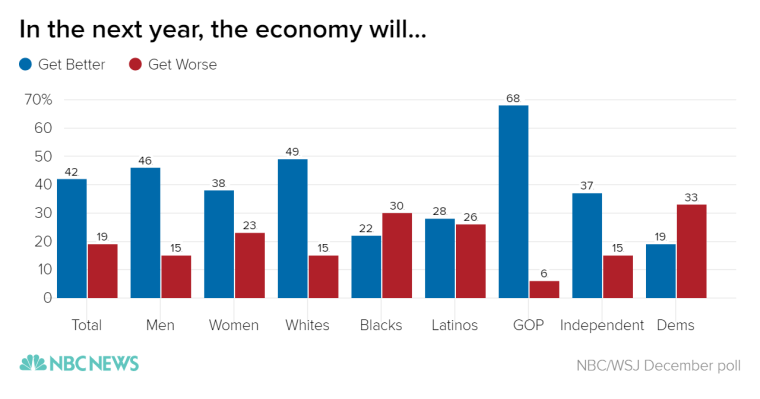
Those who say that the economy will get better in the next year rather than worse include key Trump constituency groups like whites (49 percent better compared to 15 percent worse), Republicans (68 percent better to six percent worse), and men (46 percent better to 15 percent worse.) Among Democrats, 33 percent believe the economy will get worse compared to 19 percent who believe it will improve, and just 22 percent of African Americans think the economy will improve compared to a third who say it will deteriorate.
The public also still harbors concerns about Trump's temperament. Just 36 percent of Americans say they are optimistic that Trump has the right temperament to be president, while 44 percent say they are worried about the issue.
The Republican Party gets a boost – but will it last?
In the wake of the 2016 election, the Republican Party now has a higher net favorability rating (35 percent positive, 38 percent negative) than the Democratic Party (34 percent positive, 42 percent negative). That’s the first time since after the 2010 midterms that Republicans have scored better on the favorability measure than their Democratic counterparts.
But it’s not clear that Americans’ warmer feelings toward the GOP will endure. After its previous high watermark six years ago, the party’s positive ratings quickly fell back to earth, with Democrats regaining the advantage the following month.
